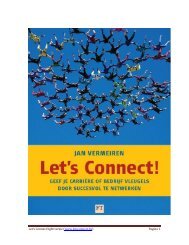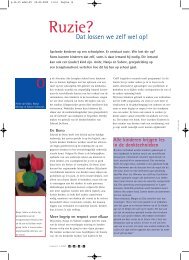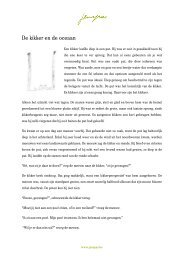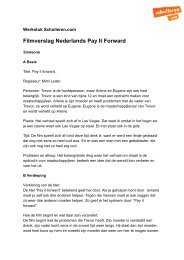Create successful ePaper yourself
Turn your PDF publications into a flip-book with our unique Google optimized e-Paper software.
WISDOM IN A NUTSHELL<br />
<strong>Six</strong> <strong>Thinking</strong> <strong>Hats</strong><br />
An essential approach<br />
to business management<br />
By<br />
Edward De Bono<br />
Back Bay Books edition by Little, Brown and Co. 1999<br />
ISBN 0 316 17791 1<br />
173 pages<br />
BusinessSummaries.com is a business book summaries service. Every week, it<br />
sends out to subscribers a 9- to 12-page summary of a best-selling business<br />
book chosen from among the hundreds of books printed out in the United States.<br />
For more information, please go to http://www.bizsum.com.
The Agenda Page 2<br />
For information on Dr. De Bono’s seminars, books, and workshops, visit:<br />
http://www.edwarddebono.com/<br />
www.bizsum.com © 2001 - 2003 Copyright BusinessSummaries.com
The Agenda Page 3<br />
The Big Idea<br />
Confusion is the biggest enemy of good thinking. Simplicity is the key. “When<br />
thinking is clear and simple, it becomes more enjoyable and more effective.”<br />
The <strong>Six</strong> <strong>Thinking</strong> <strong>Hats</strong> method is very easy to understand and therefore, simple<br />
to use. This tool can be used no matter how big or small your organization is, to<br />
create a more creative atmosphere, improve communication and train people to<br />
use a clearer way of thinking.<br />
A hat is something you can easily put on and take off. The hats are visual cues<br />
for us to allow an easy switch in our modes of thinking. The wonderful thing<br />
about this method is that it can be taught to children as well as top executives!<br />
Introduction<br />
We have to train our minds into doing one thing at a time. We cannot be<br />
emotional, logical, factual, creative, and organized all at the same time. The <strong>Six</strong><br />
<strong>Thinking</strong> <strong>Hats</strong> method lets us focus our thought process and filter out ideas and<br />
outputs. Consider this new paradigm.<br />
The Western model of thinking, which is based on argument, is not sufficient to<br />
tackle all the different problems we face in most organizations. To design a way<br />
forward, a more constructive model of thinking, The <strong>Six</strong> <strong>Hats</strong> method or “parallel<br />
thinking” is required.<br />
Parallel thinking is looking at something from all of its different angles. Each<br />
individual has a unique view of one idea or object. Put people on four different<br />
sides of a house and you will see each has his or her own perspective.<br />
Parallel thinking subscribes to the idea that everyone must try looking at the<br />
house from the same direction. The object is not to argue your point until you<br />
win, but to explore all possibilities or angles of a situation.<br />
When using the <strong>Six</strong> <strong>Hats</strong> method, all the parties involved role-play at the<br />
appointed time. No one person is assigned to be the Black Hat thinker the entire<br />
time. Everyone wears a different hat, and switches to another at the same time.<br />
This method allows people who only focus on arguments and criticism to put on<br />
their Green <strong>Hats</strong> and offer creative solutions, or with their Yellow hats, some<br />
optimistic views, for example.<br />
• The <strong>Six</strong> <strong>Hats</strong> Method is a time saving approach that cuts down long<br />
discussions. E.g. Optus (in Australia) set aside 4 hours for an important<br />
discussion. The <strong>Six</strong> <strong>Hats</strong> method enabled the team to conclude within 45<br />
minutes.<br />
www.bizsum.com © 2001 - 2003 Copyright BusinessSummaries.com
The Agenda Page 4<br />
• The <strong>Six</strong> <strong>Hats</strong> method removes the biggest obstacle to quick and effective<br />
thinking – the ego. Instead of attacking another person’s idea to show off<br />
how clever you are, with the aid of the <strong>Six</strong> <strong>Hats</strong> approach, adversarial and<br />
confrontational thinking is eliminated because your performance as a<br />
thinker can be shown off in how well you utilize each hat. Instead of egodriven<br />
meetings, meetings become more constructive, productive, and<br />
move much faster.<br />
<strong>Six</strong> <strong>Hats</strong>, <strong>Six</strong> Colors<br />
• The White Hat is neutral and objective. It is concerned with facts and<br />
figures.<br />
• The Red Hat is the realm of the emotional view and feelings.<br />
• The Black Hat is the hat of caution. It points out weaknesses in an idea.<br />
• The Yellow Hat is positive, sunny, and optimistic.<br />
• The Green Hat belongs to creativity and new ideas.<br />
• The Blue Hat is cool and like the sky, is above all. It is concerned with<br />
control, organization of the thinking process, and the use of the other hats.<br />
In practice, we refer to hats by color and never by their function:<br />
“Take off your black hat for a moment”.<br />
“Let’s put on our green hats here.”<br />
“That’s enough of the yellow hat thinking. Let’s put on the white hat.”<br />
Using the <strong>Hats</strong><br />
Single use<br />
The hat may be used to request a type of thinking to direct a discussion.<br />
Sequence use<br />
• The hats may be used one after another in a sequence.<br />
• Any hat may be used as often as you like.<br />
• The sequence may be made up of two, three, four or more hats.<br />
• A preset sequence is set up at the beginning of the meeting under an<br />
initial blue hat. The sequence is laid out in advance and followed. Minor<br />
variations are permitted depending on the output. Evolving sequences are<br />
recommended only for those who are more experienced in the <strong>Six</strong> <strong>Hats</strong><br />
method. Members may choose hats as they go, or the facilitator can. The<br />
facilitator may be viewed as manipulating the outcome, so it is better to<br />
stick to preset sequences.<br />
www.bizsum.com © 2001 - 2003 Copyright BusinessSummaries.com
The Agenda Page 5<br />
Time’s Up!<br />
Allow one minute per person for each hat. It is best to set a short time limit and<br />
only extend if there are many ideas. If nobody has anything else to add, move on<br />
to the next hat.<br />
Blue hats should be used to begin and end a meeting.<br />
• The first blue hat indicates why we are meeting, defines the problem, what<br />
the objectives are, the results we want to achieve, and the sequence plan<br />
of the hats to be used.<br />
• The final blue hat should indicate what was achieved, the outcomes,<br />
conclusions, designs, solutions, and next steps.<br />
You can sometimes put a red hat on and ask at the end of the meeting how<br />
people feel about the outcome, their thinking, and if they feel they’ve done a<br />
good job.<br />
The White Hat<br />
White hat thinking is a way of asking for facts and figures to be put forth in a<br />
neutral manner. It encourages the thinker to separate what is fact and what is<br />
interpretation.<br />
• The two tiers of facts are the believed facts or unchecked facts, and the<br />
checked facts.<br />
• The facts we cannot possibly check, the second-class, believed facts, may<br />
be put forward during white hat thinking sessions, but it must be made<br />
absolutely clear these are not checked.<br />
• The key rule for white hat thinking is that something should not be put<br />
forward at a higher level than is actually the case.<br />
• Your own opinion is never permissible under white hat thinking, but you<br />
may report the opinion of someone else.<br />
• White hat thinking encourages the right attitude of neutrality. No one can<br />
push a particular point of view, but simply lays it out on the table.<br />
• The purpose of white hat thinking is to be practical.<br />
• Anecdotes or instances fall under white hat thinking if the thinker puts<br />
them forward as such.<br />
• White hat thinking excludes opinion, intuition, judgment based on<br />
experience, feelings, and impressions.<br />
• The spectrum of likelihood under white hat thinking ranges from “Always<br />
true” to “never true”. In between are statements such as “sometimes, by<br />
and large, occasionally, been known to happen, etc”<br />
www.bizsum.com © 2001 - 2003 Copyright BusinessSummaries.com
The Agenda Page 6<br />
• White hat thinking is a discipline and direction. The thinker must strive to<br />
be more neutral and objective in the presentation of information.<br />
The Red Hat<br />
The red hat gives everyone an opportunity to express how they feel about a<br />
situation. Feelings, emotions, and intuition are in the realm of the red hat. It is<br />
always done on an individual basis, and always applied to a specific idea or<br />
situation. The thinker may not change the idea and cannot say, “I’ll pass” when<br />
asked for red hat feelings. The thinker may use terms like neutral, undecided,<br />
confused, doubtful, or mixed.<br />
The purpose of the red hat is to express feelings, as they exist. It is not designed<br />
to force a judgment.<br />
• Intuition may be based on knowledge of the market, or past experience<br />
• A hunch is a hypothesis based on intuition.<br />
• Decisions are not made solely on intuition, but red hat feelings do play an<br />
important part in many major business decisions.<br />
• The red hat legitimizes feelings as an important part of thinking.<br />
• The red hat makes feelings visible so they become part of the thinking<br />
map and also part of the value system that chooses the route on the map.<br />
• It provides a convenient method for a thinker to switch in and out of the<br />
feeling mode in a way that is not normally possible without such a device.<br />
• Under the red hat, its essence of being artificial, or formalizing the<br />
expressing of an emotion, makes it less personal.<br />
• Emotions are often used to establish bargaining positions.<br />
• There should never be an attempt to justify feelings or provide a logical<br />
basis for them.<br />
The Black Hat<br />
The black hat is the hat of caution. It is the most used hat of all the six thinking<br />
hats. It is the hat of survival. Overuse of the black hat may lead to an unhealthy<br />
cynicism where people only seem to find fault with everything.<br />
• The black hat points out errors in thinking<br />
• It is always logical<br />
• The black hat is only used when the time for critical thinking is appropriate<br />
• You cannot interrupt a non-black hat session with a black hat insight<br />
• The black hat is used to cite obstacles, difficulties, problems, and dangers<br />
• The facilitator must maintain hat discipline so people do not interrupt each<br />
other<br />
• Some people enjoy being critical, but cannot contribute a constructive<br />
option<br />
www.bizsum.com © 2001 - 2003 Copyright BusinessSummaries.com
The Agenda Page 7<br />
• Refrain from overuse of the black hat. It is easy to criticize the design of a<br />
chair, but it is more difficult to come up with a better design of your own.<br />
Criticism should be accompanied by an alternative option<br />
The Yellow Hat<br />
The yellow hat is harder to wear than the black hat, because our brains are<br />
naturally wired to think with a black hat. The black hat is the hat that has allowed<br />
human beings to evolve and survive, through the use of caution and risk<br />
management. The yellow hat is essential because it provides “value sensitivity”.<br />
It is a waste of time to set out trying to be creative, if you are not going to<br />
recognize a good idea. There are people who love to pounce on an idea and tear<br />
it to pieces. The yellow hat seeks value, so even unattractive ideas are given<br />
their due recognition.<br />
Being positive is a choice.<br />
The one thing that all successful people share in common is their desire to make<br />
things happen. Now there is such a thing as over-optimism, such as people who<br />
base their entire lives on the possibility of winning the lottery. That is sheer<br />
stupidity. The yellow hat calls for a Reasonable amount of optimism.<br />
• Yellow hat thinking is about exploring possible benefits and seeking to<br />
justify them.<br />
• Under the yellow hat, everyone is supposed to come up with his or her<br />
own proposal or idea. This is the constructive aspect of yellow hat thinking<br />
mode.<br />
• The yellow hat requires a genuine desire to put forward proposals even if<br />
they seem ordinary.<br />
• Yellow hat thinking is concerned with positive assessment.<br />
• It ranges from the logical and practical, to the dreams, visions, and hopes<br />
at the other end of the spectrum<br />
The Green Hat<br />
The green hat is the hat of energy, growth, and new ideas. A specific time is set<br />
for everyone to make a creative effort. Everyone has to submit one idea, it is no<br />
longer just the responsibility of one “ideas person” while everyone sits around<br />
waiting to critique it.<br />
• When the green hat is put on, everyone must contribute an idea, or else<br />
keep quiet.<br />
• The green hat explores possibilities.<br />
• The green hat embraces change.<br />
• The green hat is about exploring problem solving from another angle.<br />
www.bizsum.com © 2001 - 2003 Copyright BusinessSummaries.com
The Agenda Page 8<br />
• Green hat thinking is about coming up with a totally fresh approach.<br />
• Lateral thinking, or pattern switching, works when the thinker cuts across<br />
patterns instead of just following them, thus producing a Eureka effect.<br />
• “PO” is a green hat device that allows one to think and use provocative<br />
operation. E.g. Po cars would have square wheels, Po planes would be<br />
able to land upside down. Po executives should be able to promote<br />
themselves.<br />
• A concept manager has the role and responsibility of collecting,<br />
stimulating, and directing ideas put forth<br />
• The ideas generated under the green hat session are then gathered and<br />
assessed under the yellow hat for constructive development, and then the<br />
black hat may be used. At any point the white hat can be used for neutral<br />
facts or information to support or evaluate whether or not an idea will<br />
work. Red hat thinking is the last stage. Ask questions like: do we like the<br />
idea enough to proceed? Are we excited?<br />
The Blue Hat<br />
The blue hat is the hat of control. It is the hat we use for thinking about thinking. It<br />
is our “over view”. The blue hat is the agenda hat, and lays out what is to be<br />
achieved. The blue hat sets out the strategy and keeps discipline so people stick<br />
to the relevant hat. The facilitator or chairperson wears the blue hat. At the end of<br />
a session, the blue hat thinker calls for a conclusion, summary or decision and<br />
action points or next steps.<br />
• The blue hat thinker must observe the thinking that takes place, and notes<br />
the map or route that the other thinkers in the group are driving along.<br />
• The final summary or report is the realm of the blue hat.<br />
• The blue hat thinker acts as a photographer who records/documents the<br />
thinking session taking place, or in this case, the thoughts that have been<br />
set forth.<br />
Benefits of the <strong>Six</strong> <strong>Hats</strong> Method<br />
• Decision-making time is cut into less than half with the proper use of the<br />
six hats<br />
• In the end, all final decisions are really Red Hat or emotional decisions.<br />
• The first purpose of the 6 <strong>Hats</strong> Method is to simplify thinking so we can<br />
deal with one thing at a time. The second main purpose of the method is<br />
to allow an easy switching device. This does not threaten egos and can be<br />
played like a game.<br />
www.bizsum.com © 2001 - 2003 Copyright BusinessSummaries.com








